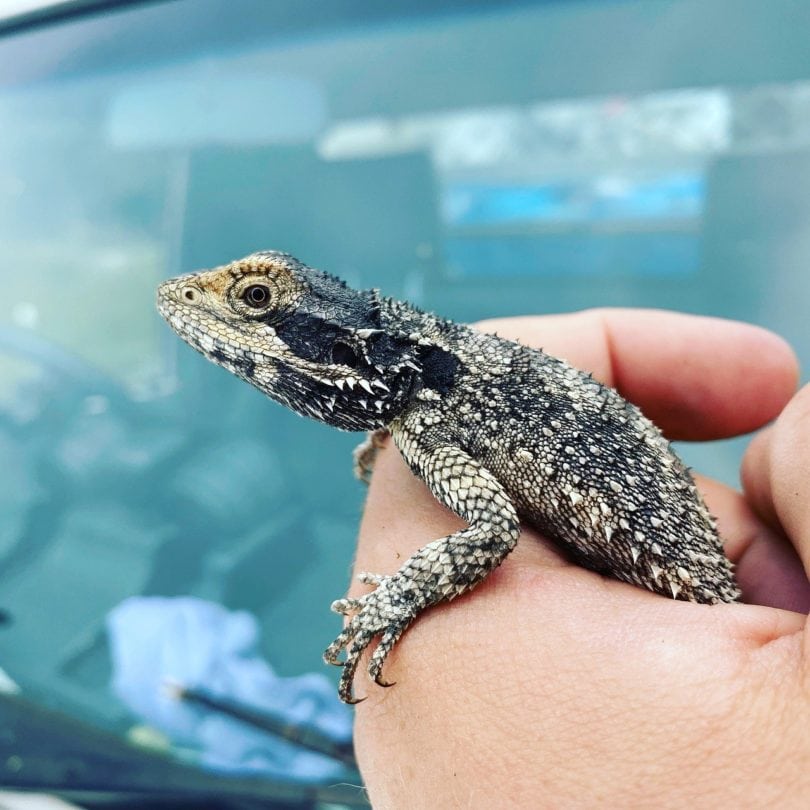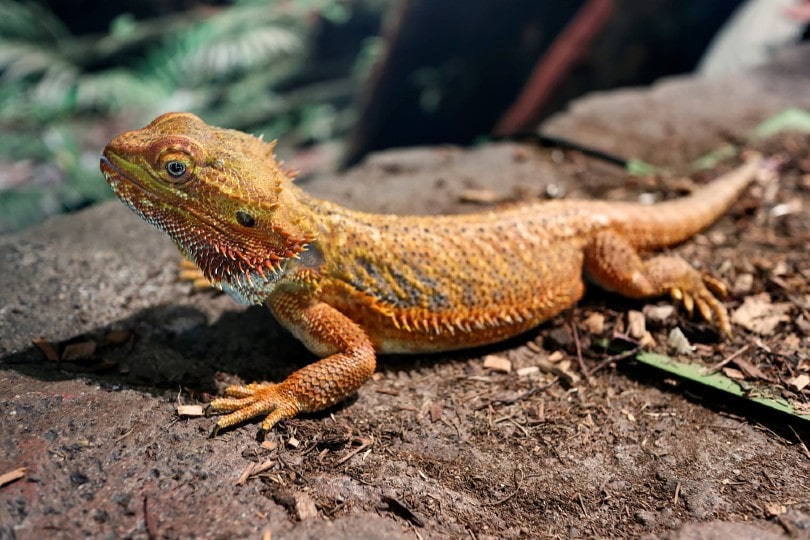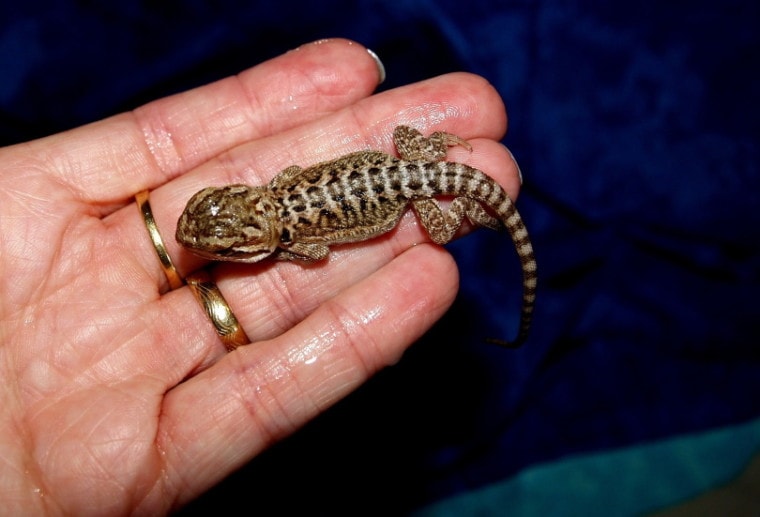
Click to Skip Ahead
Bearded Dragons are one of the most popular pet reptiles because they have big but gentle personalities and are a little more adventurous than many other reptiles. They also reproduce readily, making them an affordable fit for the pet trade. Bearded Dragons aren’t particularly difficult to care for and make great pets for beginner reptile owners, but that doesn’t mean they don’t require specialized care. Keep reading for more information on caring for a Bearded Dragon.
Bearded Dragon Facts
Bearded Dragons originated in Australia and were introduced to the US as pets in the 1990s. In the 1960s, Australia banned the sale of their native animals, so pet Beardies in the US today are all bred under human care. They can live to be 15 years old with proper care and can reach sizes up to 24 inches in length. Most Bearded Dragons are sold when they are juveniles and are usually only around 5-10 inches.
There are multiple species of lizard that are often called Bearded Dragons, but they are all part of the Pogona genus. Pogona vitticeps, or the Inland Bearded Dragon, is the most commonly seen Bearded Dragon in the pet industry and is sometimes referred to as the Yellow-headed Bearded Dragon or the Central Bearded Dragon. Other species in the Pogona genus include the Common Bearded, Rankin’s, Northwest Bearded, Western, and Dwarf.
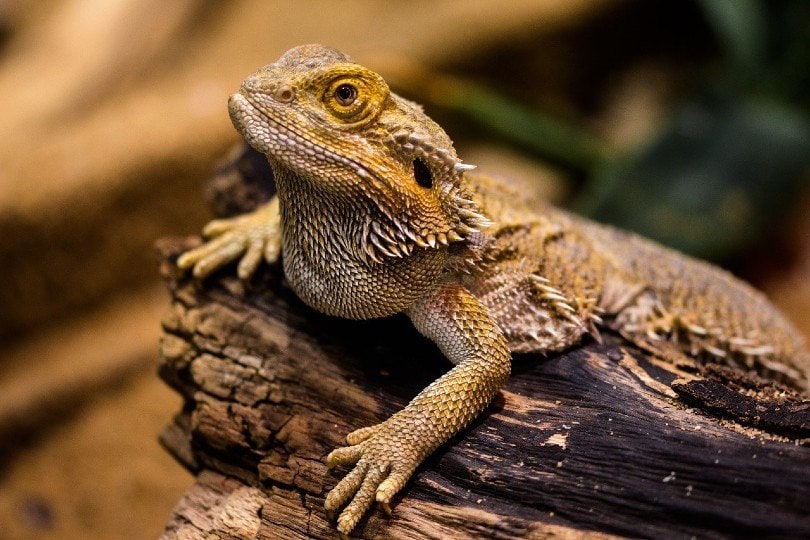
Are Bearded Dragons Good Pets?
Bearded Dragons are known as docile and inquisitive pets, making them great companions. They are naturally diurnal, or active during the day, so Beardie owners will routinely see them out in their enclosure. They spend most of the daylight hours basking or eating, and they tend to sleep through the night like humans.
They are relatively easy reptiles to care for, but that’s not to say they don’t require some daily care. You’ll need to check their enclosure substrate daily to ensure it’s not soiled with waste. They also require clean water at all times, and anything not drunk should be refreshed with clean water. Beardies should be fed once daily, although juveniles and hatchlings require more frequent feedings. Adults are mostly herbivorous, so you’ll need to ensure they receive fresh veggies daily and nothing is allowed to rot in the enclosure.
Appearance
Most Bearded Dragons look very similar when it comes to their appearance. An adult Bearded Dragon can grow to anywhere between 30 to 60 centimeters as adults depending on the exact species. They have a long tail that is usually as long as their body is, a flat body, a broad head, and short legs. One of the most characteristic features of a Bearded Dragon is the spikes that are found on their head and on their throat, hence the name “bearded.” They are tan and brown in color.
How to Take Care of a Bearded Dragon
Habitat, Tank Conditions & Setup
The minimum size tank an adult Beardie should be kept in is 55 gallons, but larger is better. This enclosure will need plenty of space for basking and allow your Bearded Dragon the ability to get away from the heat when they want to. This enclosure will also need a well-fitting lid to prevent any escape attempts.
Light and Heat
Your Bearded Dragon will need access to a heat lamp that allows them to bask, but they’ll also need plenty of space to get away from the heat when needed. You will also need a light that provides UVB rays to help your Beardie keep vitamin D and calcium levels up.
Substrate
While there are a lot of substrates that can be used with Bearded Dragons, it’s important to consider that they tend to have messy poos. Many people find that hard substrates, like tile, or reptile mats that can easily be rinsed and replaced are the easiest substrates to keep clean and hygienic. Paper towels and newspaper make great substrate for something you can toss when it’s dirty, and excavator clay is a nice pick for the creative owner who wants to build caves and hills. Avoid sand or anything your Beardie may accidentally eat, especially in hatchlings and juveniles, as this can lead to a deadly intestinal impaction.
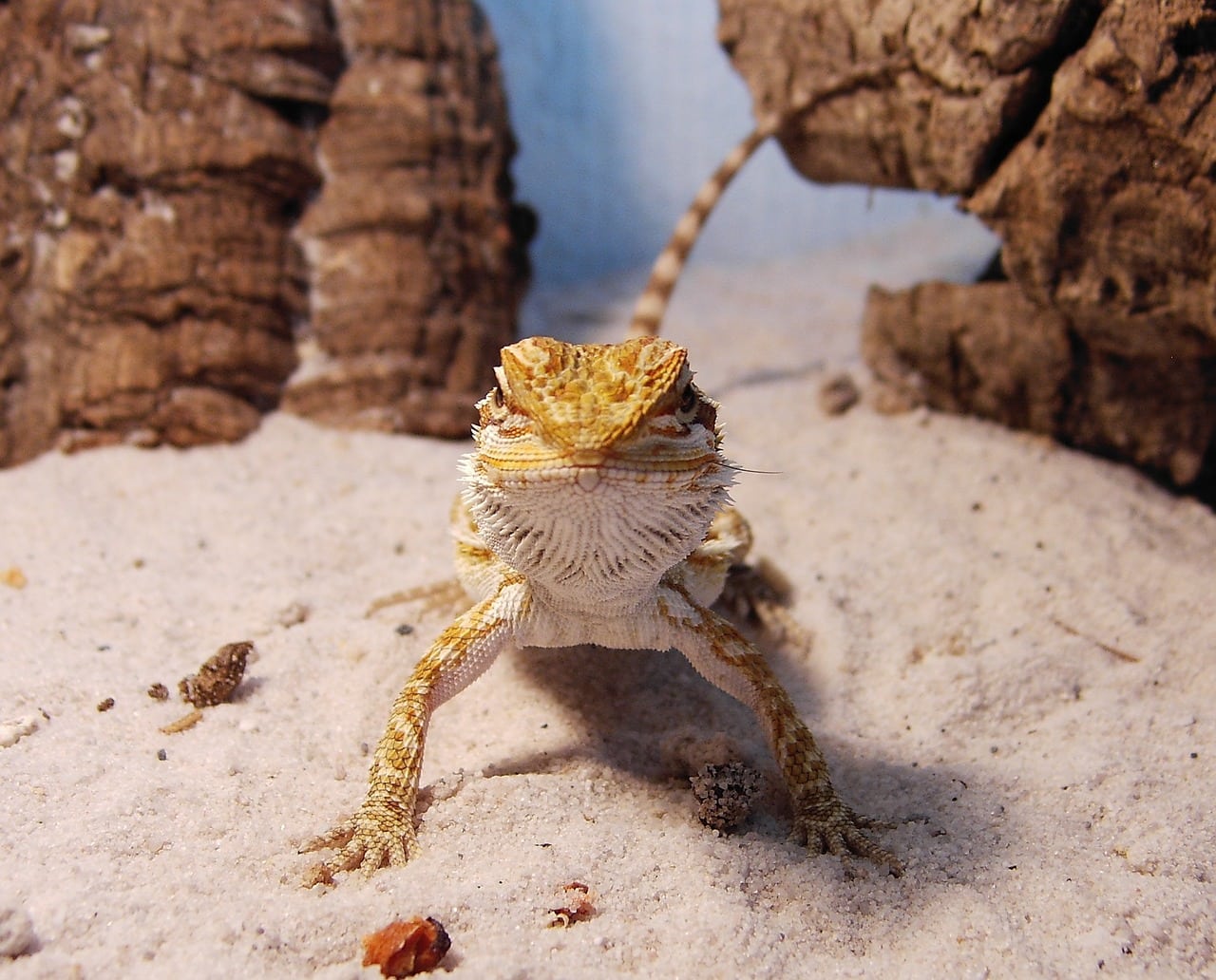
Accessories
Your Bearded Dragon will need a basking station, including a raised basking platform that does not put them near enough to the heat lamp to get burned. Bridges, caves, and even driftwood can make great additions to the enclosure, as well as fake or real plants. Just remember that all live plants should be 100% Beardie safe in case they attempt to eat them.
Feeding Your Bearded Dragon
Bearded Dragons should always have access to fresh, clean water in a shallow dish. The dish should not be deep enough for them to get stuck inside or drown. A food dish is a good way to keep the enclosure clean, but it won’t work well for insects like roaches and crickets.
Adult Bearded Dragons need around 80% of their diet to be veggies, which usually consists of salad greens and other veggies as treats. The other 20% of their diet should consist of proteins, including dubia roaches, crickets, and super worms. Adults should receive insects daily in small quantities or every other day in larger quantities. Keep in mind that adults are over the age of 18 months. Veggies should be added to the diet around 12 months. They should receive a vitamin supplement, calcium, and vitamin D. Clean water should always be available.
Hatchlings, which are under the age of 2 months, should be fed insects around five times daily while they are growing rapidly. From 2-6 months, they should be fed three or four times daily and by 6 months, they should only be getting fed three times daily. By 12 months old, feedings should be down to twice daily and weaned downward until 18 months. Insects should be dusted with calcium and other vitamin supplements for growing Beardies may need to be added.
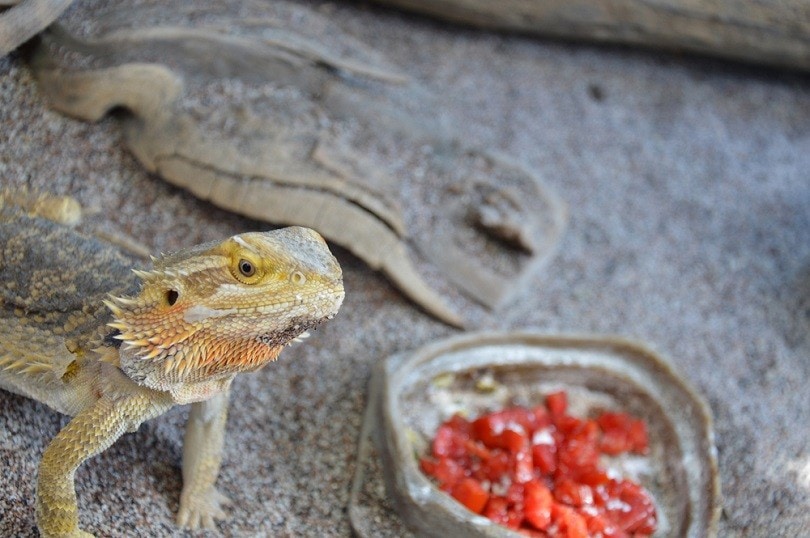
Keeping Your Bearded Dragon Healthy
Feeding
For adult Bearded Dragons, provide fresh veggies daily. Uneaten food should be removed from the enclosure within 12-24 hours. Veggies should account for 70-80% of an adult Beardie’s diet and can be offered all the time unless otherwise advised by your vet.
Common Health Issues to Look For
Metabolic Bone Disease
This disease is caused by improper husbandry, especially the lack of bioavailable calcium in the diet. It can also be caused by low vitamin D levels and a lack of UVB lighting. At its core, MBD is always defined by low calcium levels, regardless of cause. Signs include limb twitching, mouth swelling, paralysis, muscle wasting, bone deformities, severe lethargy, inappetence, and constipation. Bearded Dragons with signs of MBD should see a veterinarian since the disease is often advanced when signs are noticeable.
Mouth Rot
Also known as ulcerative or infectious stomatitis, mouth rot is caused by poor dental hygiene, specifically, micro-cuts in the gums and food stuck in the mouth. Poor husbandry leading to stress can increase the risk of developing mouth rot. Signs include poor appetite, refusing to drink, dehydration, thickened secretions from the mouth, yellowing areas in the mouth, and swelling of the gums, mouth, or face. If you see these signs, you should have your Bearded Dragon evaluated by a veterinarian. It’s a good idea to give them a run-down of your current care routine so they can make recommendations for husbandry changes.
Upper Respiratory Infections
Upper respiratory infections, or URI, are caused by environmental factors, including high humidity and moisture levels, stress, other illnesses, and poor enclosure hygiene and maintenance. Prevention is your best weapon against URI. Signs of an upper respiratory infection include increased respiratory rate, increased work of breathing, labored breathing, wheezing, lethargy, and inappetence. If you think your Bearded Dragon might have a URI, it’s imperative you get them to a vet ASAP. Respiratory infections are prone to worsening quickly and can be deadly.
Adenovirus/Atadenovirus
This disease is very serious and often fatal. It’s also known as wasting disease and stargazing disease. It can cause muscle wasting, seizures, twitching, muscle spasming resulting in the head looking upward (“stargazing”), severe lethargy, and inappetence. It will eventually lead to kidney, liver, or neurological dysfunction, encephalitis, gastroenteritis, and other serious problems. It’s difficult to diagnose and is often not accurately diagnosed until a post-death necropsy.
Bathing
Baths aren’t necessary for most Bearded Dragons except under specific circumstances. If your Beardie tracks through waste, then you may need to provide a quick bath or wipe down. Constipation and stuck shed can both be improved with lukewarm water soaks. It’s unnecessary to add soaps or anything else to these baths unless recommended by your veterinarian.
Enclosure Care
Some enclosure maintenance will need to be performed on a daily basis, including removing uneaten food, providing clean water, and cleaning up solid waste. If your substrate is solid, like tile, then it should be disinfected with reptile-safe products every week or so. Reptile mats and other coarse-textured substrates may require more frequent cleaning since it can be difficult to adequately wipe up waste. Paper towels and newspaper should be replaced whenever wet or soiled.
Image Credit: Pixabay
Lifespan
Bearded dragons can live up to 15 years in the wild. However, when kept as pets, Bearded Dragons may live up to 20 years. This increased lifespan under human care is due to lack of predators and a more controlled environment. However, in order for your Bearded Dragon to live for that long, they must be cared for properly and given the proper veterinary care.
Breeding
Breeding Bearded Dragons is not hard to do, and they can be bred year-round. However, it’s important to know what you’re doing, so it’s best to ask a vet how to properly breed your bearded dragon. If a male is ready to breed a female, he may follow her around the enclosure and bite her neck when breeding is ready to begin. If the breeding is successful, the female will usually lay her eggs 4 to 6 weeks after breeding, and it will take around 2 months for the eggs to hatch.
Are Bearded Dragons Friendly? Our Handling Advice
Young Bearded Dragons will need routine handling to get used to people, but once they are used to being handled, most Bearded Dragons are comfortable with it. Many people even have leashes for their Beardies and take them on walks in safe areas for enrichment. However, they are not fans of long travel and it’s best to leave them at home when you go on vacation.
Shedding and Brumation: What to Expect
As Beardies age, their shedding decreases from weekly to every 4 to 6 months by adulthood. If you notice shedding problems, lukewarm water soaks can help loosen the stuck skin. Sometimes, your Bearded Dragon’s appetite will decrease during shedding and they often eat their own shed skin once finished.
Brumation is a form of semi-hibernation, also known as torpor. During the winter, Bearded Dragons will enter a state of brumation, which will cause them to have a significantly reduced appetite and they will seem to have lethargy or sleep a lot. If you’re unsure if your Beardie is sick or entering brumation, you can have your vet check your Beardie over to be safe. Otherwise, you will need to reduce feeding during this period but keep a light and heat lamp available if your Bearded Dragon needs them.
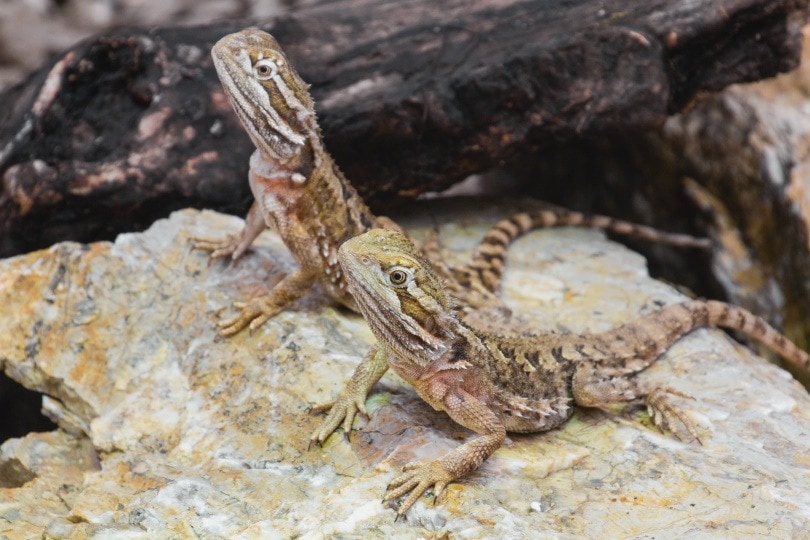
How Much Do Bearded Dragons Cost?
When it comes to purchasing your Bearded Dragon, it’s highly likely that you’ll be able to get one for less than $100 unless you are purchasing an unusual Beardie, which can easily cost hundreds of dollars. Your biggest initial expenses aside from the Bearded Dragon itself is an appropriate enclosure and all necessary accessories. You’ll need an adequate enclosure, basking area, heat lamp, UV lamp, enclosure substrate, and food, which will cost you anywhere from $150 to $500. The larger and more elaborate of an enclosure you buy, the more expensive it will be.
Feeding your Bearded Dragon will cost you approximately $10 per week, which includes the cost of food and supplements. Younger Beardies may cost you more because they require more live insects than adults do. When you first bring your Bearded Dragon home, getting a vet checkup to verify its health is the safest way to go, which will cost you around $75 but may be more or less depending on the vets in your area. While not required, an annual vet checkup isn’t a bad idea to help catch any problems early, which will probably cost you $60 or more. Treating illnesses and emergencies will cost upwards of $100, so you may keep a fund set aside for emergency expenses.
Where Can I Get a Bearded Dragon?
Finding a Bearded Dragon is usually an easy task. Big box pet stores usually sell them, and smaller pet stores often keep them in stock as well. If you live in an area without pet stores that sell reptiles, finding breeders online shouldn’t be too difficult. If purchasing from a breeder, it’s a good idea to read reviews and check with people who have purchased from them before if possible. This will help you ensure that you’re going to receive a healthy Beardie. Some breeders and stores are unscrupulous and won’t think twice about selling unhealthy animals, so keep a close eye out for this when you’re in the market for a Beardie.
Final Thoughts
Caring for a Bearded Dragon doesn’t have to be terribly complicated but bringing home a Beardie should only be done after careful consideration of the care and costs associated with them. They make great pets, and it can be rewarding to keep them as pets. They enjoy human interaction and can recognize people, helping them bond with you. With proper husbandry, they’ll be with you for years to come!
You may also like:
Featured Image Credit: Milchdrink, Pixabay


